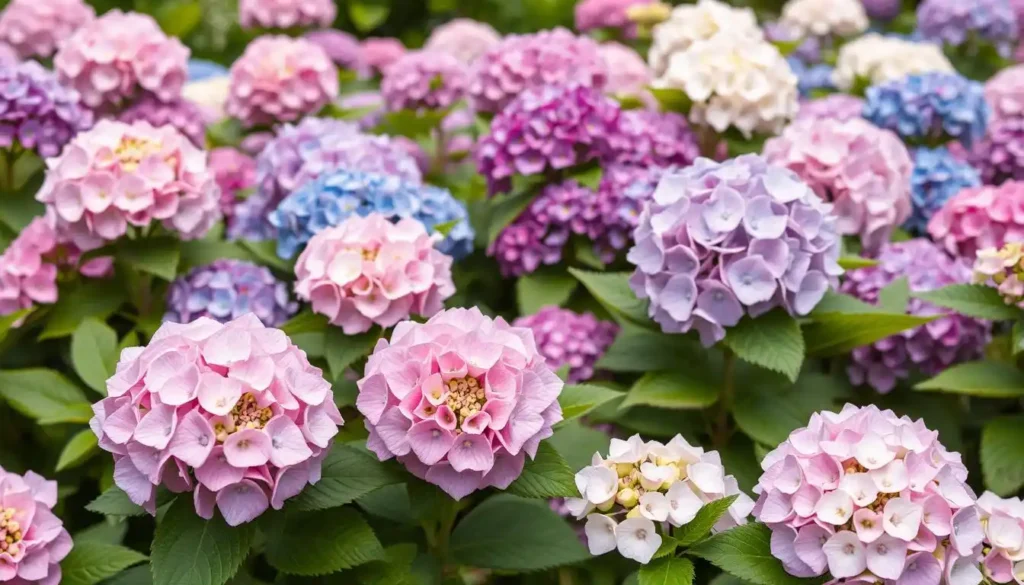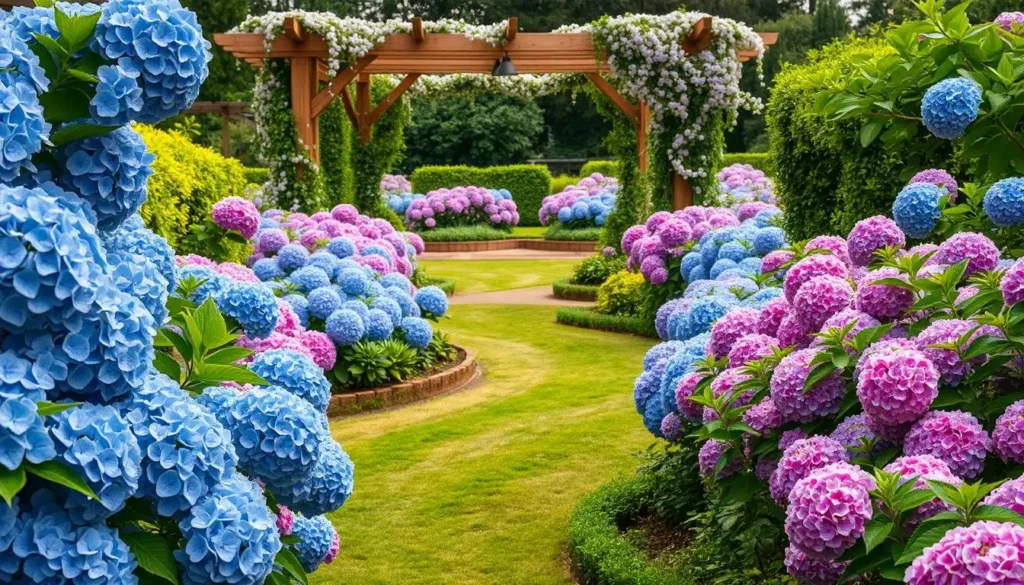Are you ready to create a stunning hydrangea garden that will leave your neighbors in awe? With the right techniques and knowledge, you can enjoy vibrant blooms that add color and beauty to your outdoor space.
Discover the secrets to making your hydrangea varieties thrive and produce jaw-dropping color. From soil preparation to pruning techniques, this article will guide you through the process of creating a breathtaking display.
Key Takeaways
- Learn how to choose the right hydrangea varieties for your climate.
- Understand the importance of soil preparation for optimal blooms.
- Discover pruning techniques to enhance your hydrangea’s color and health.
- Explore tips for maintaining a vibrant hydrangea garden throughout the season.
- Get insights into common mistakes to avoid when growing hydrangeas.
The Magic of Hydrangeas: Nature’s Color Chameleons
Hydrangeas are loved for their grand look and color changes. These flowers amaze gardeners everywhere with their color-shifting magic. They add a special touch to any garden.

Hydrangeas are more than just beautiful flowers. They have traits that make them unique in gardening. Whether you’re new or experienced, hydrangeas offer a captivating experience.
Why Hydrangeas Captivate Gardeners Worldwide
Hydrangeas attract gardeners with their large, showy blooms and adaptability. They can grow well in different conditions. Gardening expert says, “Hydrangeas are great for adding drama to gardens.”
“Hydrangeas are a gardener’s delight, offering a kaleidoscope of colors and a long blooming season that keeps gardens vibrant throughout the summer.”
The Science Behind Hydrangea’s Color-Changing Abilities
The color change in hydrangeas depends on the pH level of the soil. Acidic soils make blue flowers, while alkaline soils make pink ones. This lets gardeners change their hydrangea colors by adjusting the soil pH.
To get blue blooms, add elemental sulfur or aluminum sulfate to lower the soil pH. For pink blooms, use lime to raise the pH. Knowing this science lets gardeners create a unique and changing garden landscape.
Understanding Hydrangea Varieties for Your Garden
To make your hydrangea garden stunning, knowing the different types is key. There are many varieties to pick from. You can match your garden to your climate, space, and the color you want.
Bigleaf Hydrangeas (Hydrangea macrophylla)
Bigleaf hydrangeas are very common. They have big, colorful flowers that change color based on the soil. They grow best in zones 5-9 and need moist, well-draining soil. These hydrangeas add vibrant colors to your garden.
Panicle Hydrangeas (Hydrangea paniculata)
Panicle hydrangeas are tough and versatile. They grow cone-shaped flowers in white and pink. They can handle different soils and full sun, making them great for many gardens.
Oakleaf Hydrangeas (Hydrangea quercifolia)
Oakleaf hydrangeas have unique leaves that look like oak leaves. They have white flowers that turn pink as they age. They like well-draining soil and partial shade, growing well in zones 5-9. Their leaves turn red in fall, adding beauty to your garden.
Smooth Hydrangeas (Hydrangea arborescens)
Smooth hydrangeas are loved for their big, white flower clusters. They are easy to care for and can grow in many conditions. This makes them a favorite among gardeners.
Climbing Hydrangeas (Hydrangea anomala)
Climbing hydrangeas grow fast and can cover walls or trellises with their green leaves and white flowers. They do best in partial shade and well-draining soil. They add vertical beauty to your garden.
| Hydrangea Variety | Flower Color | Hardiness Zones | Special Features |
|---|---|---|---|
| Bigleaf | Blue or Pink | 5-9 | pH-dependent flower color |
| Panicle | White to Pink | 3-8 | Cone-shaped flowers |
| Oakleaf | White to Pinkish | 5-9 | Distinctive oak-shaped leaves, fall color |
| Smooth | White | 3-9 | Low maintenance |
| Climbing | White | 4-8 | Vigorous climber, vertical interest |

Creating Your Perfect Hydrangea Garden Layout
Creating a hydrangea garden that blooms all season needs careful planning. You must know your garden’s conditions well. A well-planned hydrangea garden makes your outdoor space more beautiful. It also becomes a place for relaxation and fun.
Assessing Your Garden’s Growing Conditions
Before planting hydrangeas, check your garden’s growing conditions. Look at sunlight, soil type, and drainage. Most hydrangeas like partial shade to full sun and well-draining soil. Knowing this helps pick the right hydrangea varieties for your garden.
Selecting the Right Hydrangeas for Your Space
There are many hydrangea types to choose from. Think about the plants’ mature size, bloom time, and color. For a big impact, look at hydrangea plants for sale from good nurseries. They have many varieties to choose from.

Designing for Continuous Blooms Throughout the Season
To keep your hydrangea garden colorful all season, pick varieties that bloom at different times. This way, you get color and interest all season. As one hydrangea stops blooming, another starts, making a beautiful display.
Mapping Out Your Hydrangea Garden
After picking your hydrangeas, plan out your garden. Think about the plants’ mature size and leave enough space for them to grow. A good hydrangea garden layout looks great and helps plants grow well. Remember, a beautiful hydrangea garden shows your style and offers beauty and peace.
“A hydrangea garden is not just a collection of plants; it’s an experience that evolves with the seasons, offering beauty, tranquility, and a connection to nature.”
The Soil Secret: Manipulating pH for Spectacular Color
Discover how to make your hydrangea colors pop by learning about soil pH. The color of your hydrangea bushes depends on your soil’s acidity or alkalinity. Knowing this can help you get the blue, pink, or mix of colors you want.
Understanding the pH-Color Relationship
The pH of your soil affects your hydrangea blooms’ color. Bigleaf hydrangeas bloom blue in acidic soil (pH below 6.0) and pink in alkaline soil (pH above 7.0). This is because acidic soil has more aluminum ions, which change flower color.
Testing Your Soil’s pH Level
To find your soil’s pH, use a DIY kit or send a sample to a lab. These tests show your soil’s pH level. This info helps you decide how to adjust it.
Creating Acidic Soil for Blue Hydrangeas
To grow blue hydrangeas, acidify your soil. Use elemental sulfur or aluminum sulfate to do this. Peat moss also lowers pH over time. Keep an eye on your soil’s pH since it can change.
Creating Alkaline Soil for Pink Hydrangeas
For pink hydrangeas, make your soil more alkaline. Adding limestone raises your soil’s pH. Dolomitic limestone is great because it also adds magnesium, a key nutrient.
Maintaining Purple and Multicolored Blooms
Purple and multicolored hydrangeas need a balanced soil pH. Keep your soil pH steady and use compost for consistent nutrients.
Sourcing and Selecting Quality Hydrangea Plants
Starting a stunning hydrangea garden means finding the right plants. Whether you’re new or experienced, picking the best hydrangeas is key. They bring vibrant colors and lush blooms to your garden.
What to Look for When Buying Hydrangea Plants
When buying hydrangeas, look for plants with healthy leaves and strong roots. Make sure they don’t have diseases or pests. Also, pick varieties that fit your climate and soil.
Best Places to Buy Hydrangea Plants
You can find hydrangeas at local nurseries, gardening stores, and online. Reputable online sellers offer many varieties and advice. Local gardens and recommendations can also help you find good sources.
Popular Hydrangea Cultivars for Dramatic Color
For bold colors, try ‘Endless Summer’ or ‘Limelight’. ‘Endless Summer’ blooms on both old and new wood. ‘Limelight’ has stunning lime-green flowers. These varieties are known for their vibrant colors and are easy to find.
Small Hydrangea Varieties for Limited Spaces
For small spaces, consider ‘Tardiva’ or ‘Bobo’. These small hydrangeas are great for containers or small gardens. They add big color without taking up much space.
Planting Techniques for Thriving Hydrangea Bushes
Starting with the right planting techniques is key for healthy hydrangea bushes. Timing, spacing, and soil preparation are all important. They help your hydrangeas grow well.
Best Times to Plant Hydrangeas
The best time to plant hydrangeas varies by climate. Generally, spring or fall are best. These seasons have mild weather and plenty of moisture.
Proper Spacing and Placement
Spacing is very important when planting hydrangeas. Most need 3 to 6 feet between them. This allows for growth and air flow.
Step-by-Step Planting Guide
Here’s how to plant hydrangeas right:
- Dig a hole twice as wide and just as deep as the root ball.
- Mix in organic matter like compost to improve soil.
- Place the hydrangea in the hole, making sure the root flare is level.
- Fill the hole with soil, tamping it down to remove air pockets.
- Water well to settle the soil.
| Planting Factor | Recommendation |
|---|---|
| Soil Preparation | Add organic matter like compost |
| Spacing | 3 to 6 feet between plants |
| Watering | Water thoroughly after planting |
Seasonal Care for Vibrant Hydrangea Plants
To keep your hydrangeas looking great, adjust your care with the seasons. Each season brings its own challenges and chances for these plants to shine.
Spring Care: Awakening Your Hydrangeas
When spring comes, hydrangeas wake up from their winter sleep. Start by cleaning up dead leaves and debris around the plants. Prune old wood to encourage new growth, but be gentle to avoid damaging buds.
For Bigleaf Hydrangeas, be careful since they bloom on old wood.
Summer Maintenance for Maximum Blooms
In summer, hydrangeas are in full bloom. Make sure they get enough water, especially when it’s hot. Mulching helps keep moisture in and weeds out.
Use a balanced fertilizer to help them grow strong and bloom well. Panicle Hydrangeas and Smooth Hydrangeas do well with regular deadheading to get more flowers.
Fall Preparation for Winter Protection
In fall, stop fertilizing to help hydrangeas get ready for winter. Remove any spent blooms to keep the plants looking neat and focused on growing roots. For Climbing Hydrangeas, make sure supports are secure to protect against winter winds.
Winter Protection Strategies
Winter care is key for hydrangeas, especially in cold areas. Use a thick layer of mulch to keep roots warm. Wrap plants in burlap or a frost blanket to protect them from harsh winds and cold.
Oakleaf Hydrangeas are pretty hardy but still need a good mulch layer.
By following these seasonal care tips, you can enjoy vibrant hydrangeas all year. Tailored care for Bigleaf, Panicle, and other varieties will help them thrive in your garden.
Pruning Secrets: When and How to Cut for More Blooms
Pruning hydrangeas needs knowledge of their blooming cycles. This is crucial for the right effect. Each type of hydrangea blooms differently, and knowing this is essential.
Understanding Hydrangea Blooming Cycles
Hydrangeas bloom on either old or new wood. Bigleaf and oakleaf hydrangeas bloom on old wood. Panicle and smooth hydrangeas bloom on new wood.
Pruning Guidelines by Hydrangea Type
Bigleaf and Mountain Hydrangeas
Prune bigleaf and mountain hydrangeas right after they bloom. This way, you won’t cut off next year’s flowers.
Panicle and Smooth Hydrangeas
Prune panicle and smooth hydrangeas in late winter or early spring. Do this before new growth starts.
Oakleaf and Climbing Hydrangeas
Prune oakleaf hydrangeas after they bloom. Climbing hydrangeas need little pruning, mainly to keep them in check.
| Hydrangea Type | Pruning Time | Pruning Tips |
|---|---|---|
| Bigleaf & Mountain | After blooming | Remove dead flowers and shape |
| Panicle & Smooth | Late winter/early spring | Cut back to ground level |
| Oakleaf & Climbing | After blooming (Oakleaf) | Minimal pruning, size control |
Common Pruning Mistakes to Avoid
Pruning at the wrong time is a big mistake. It can cut off potential blooms. Always check the specific pruning needs of your hydrangea type.
Design Inspiration for a Show-Stopping Hydrangea Garden
With the right design, you can make a stunning hydrangea garden. It will show off these flowers beautifully. A well-designed garden can make your outdoor space stand out.
Creating Stunning Hydrangea Focal Points
Make a dramatic focal point by grouping hydrangeas together. This will catch the eye and add depth and interest.
Companion Plants That Enhance Hydrangea Displays
Companion plants can make your hydrangea garden even more beautiful. Try pairing hydrangeas with hostas, daylilies, or boxwood. This will make your garden lush and appealing.
- Hostas provide a beautiful contrast in texture and color
- Daylilies add a pop of color and create a dynamic display
- Boxwood provides a neat and tidy border around your hydrangeas
Container and Small Space Hydrangea Gardens
You can still have a beautiful hydrangea garden even with limited space. Use small hydrangeas in containers or hanging baskets. This will add color and beauty to your outdoor area.
Hydrangea Garden Themes and Color Schemes
Choose a theme or color scheme that goes well with your hydrangeas. This will make your garden even more beautiful. Popular themes include a cottage garden or a monochromatic color scheme.
Conclusion: Your Path to Hydrangea Garden Excellence
Now you know how to make a stunning hydrangea garden. You can pick the best plants for your area and the colors you like. This will make your garden stand out.
Start by looking at hydrangea plants for sale at good nurseries or online. This article has tips to help you. Soon, your garden will be the talk of the town.
Make sure your garden is ready for hydrangeas. Choose the right ones and take good care of them. With a bit of effort, you’ll see beautiful blooms soon.
FAQ
What are the different types of hydrangea plants available for sale?
You can find many types of hydrangea plants. These include Bigleaf, Panicle, Oakleaf, Smooth, and Climbing hydrangeas. Each type has its own look and growing needs.
How do I change the color of my hydrangea blooms?
To change your hydrangea blooms’ color, adjust your soil’s pH level. For blue blooms, make the soil more acidic. For pink blooms, make it more alkaline.
What are some popular hydrangea varieties for dramatic color?
For dramatic color, consider ‘Limelight’ and ‘Pinky Winky’ panicle hydrangeas. Also, ‘Twist-n-Shout’ bigleaf hydrangeas and ‘Snow Queen’ oakleaf hydrangeas are great choices.
Can I grow hydrangeas in small spaces or containers?
Yes, you can grow hydrangeas in small spaces or containers. Look for compact or dwarf varieties like ‘Tardiva’ or ‘Bobo’ hydrangeas. They’re perfect for small gardens or container gardens.
How often should I water my hydrangea plants?
Hydrangeas need consistent moisture, especially in hot summer months. Water them deeply once or twice a week, depending on the weather.
What are some common mistakes to avoid when pruning hydrangeas?
Avoid pruning hydrangeas at the wrong time. Don’t cut off old wood. And make sure to remove dead or damaged branches.
Can I see pictures of different hydrangea varieties to help me choose?
Yes, you can find many pictures of different hydrangea varieties online or in gardening books. They can help you pick the right one for your garden.
How do I care for my hydrangea bushes during the winter?
To care for your hydrangea bushes in winter, protect them from extreme cold and wind. Consider applying a layer of mulch or straw to keep the roots warm.

